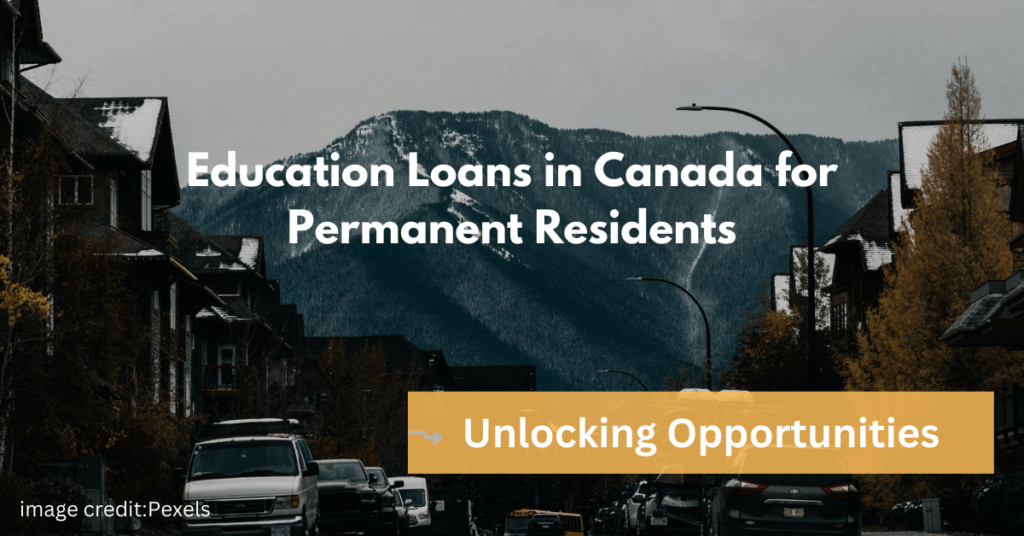Unlocking Opportunities: Education Loans in Canada for Permanent Residents. Education is a powerful tool for personal and professional growth, and Canada offers a wealth of opportunities for its permanent residents to pursue higher education. However, the cost of tuition, living expenses, and other fees can be daunting. Fortunately, education loans tailored for permanent residents in Canada can make quality education more accessible. This guide explores the key aspects of education loans in Canada, including eligibility, application processes, types of loans, and practical tips for managing educational finances.

Why Consider an Education Loan in Canada?
Canada’s education system is renowned for its quality, but the costs can be substantial. On average, tuition fees for domestic students range from CAD 6,000 to CAD 10,000 annually, with additional living expenses of approximately CAD 10,000 to CAD 15,000. Education loans help bridge the financial gap, enabling students to focus on academics without worrying about immediate monetary constraints.
For permanent residents, access to education loans is typically easier compared to international students. They often benefit from lower interest rates, government-backed financial aid programs, and tailored repayment plans.
Types of Education Loans Available in Canada
- Government-Backed Student Loans
The Canadian government provides financial assistance through programs like the Canada Student Loans Program (CSLP). This program is available to Canadian citizens, permanent residents, and protected persons. Key features include:- Interest-free status while enrolled in full-time studies.
- Income-driven repayment plans to ease post-graduation financial burdens.
- Ontario Student Assistance Program (OSAP).
- British Columbia Student Assistance Program (BCSAP).
- Quebec Loans and Bursaries Program.
- Bank Loans and Private Lenders
Major banks and private financial institutions in Canada, like RBC, TD Bank, and Scotiabank, offer education loans specifically designed for students. These loans often cover:- Tuition fees.
- Accommodation.
- Books and supplies.
- Miscellaneous living expenses.
- Line of Credit for Students
Some financial institutions provide lines of credit for students, offering more flexibility than traditional loans. Students can borrow only what they need and pay interest only on the amount used. Popular options include:- RBC Royal Credit Line for Students.
- TD Student Line of Credit.
- Scholarships and Grants
Although not loans, scholarships and grants are excellent financial resources that don’t require repayment. Permanent residents are eligible for various merit-based and need-based scholarships.
Eligibility Criteria for Education Loans
While each lender or program has specific requirements, common criteria include:
- Residency Status: Applicants must be permanent residents of Canada.
- Enrollment: Proof of enrollment in a recognized educational institution.
- Credit History: A good credit score is often required for private loans.
- Income/Guarantor: Some lenders may ask for proof of income or a co-signer to ensure repayment capability.
- Course Type: Loans are typically available for full-time and, in some cases, part-time programs.
How to Apply for an Education Loan
- Research Loan Options
Start by comparing various loan options, including government programs, bank loans, and private lenders. Assess factors like interest rates, repayment terms, and eligibility. - Gather Required Documents
Commonly required documents include:- Proof of permanent residency.
- Admission letter from the educational institution.
- Proof of tuition fees and other expenses.
- Identification documents (passport, PR card, etc.).
- Credit history or co-signer details (if applicable).
- Complete the Application
Submit your application online or in-person, depending on the lender’s process. Ensure all details are accurate to avoid delays. - Await Approval
Once your application is reviewed, you’ll receive a decision. If approved, you’ll be informed of the loan amount, interest rate, and repayment terms.
Managing Your Education Loan
Securing a loan is just the beginning; effective management is crucial to avoid financial stress. Here are some tips:
- Budget Wisely
Plan your expenses meticulously to ensure the loan covers essential needs without overspending. - Understand Repayment Terms
Familiarize yourself with your loan’s repayment schedule. Some loans require repayment to begin immediately, while others allow a grace period after graduation. - Work Part-Time
Many Canadian permanent residents can legally work part-time while studying. This additional income can help reduce reliance on loans. - Seek Loan Forgiveness or Assistance Programs
Certain provinces offer loan forgiveness programs for students in specific fields, such as healthcare or education. Check if you qualify for any such programs.
Benefits of Education Loans for Permanent Residents
- Accessibility
Loans provide access to quality education without upfront financial strain. - Low-Interest Rates
Permanent residents often qualify for competitive interest rates, reducing the overall cost of borrowing. - Flexibility
With options like lines of credit, borrowers can manage their funds efficiently. - Building Credit History
Responsible repayment of education loans helps establish a strong credit profile, beneficial for future financial needs.
Final Thoughts
Education loans are a stepping stone to achieving your academic and career aspirations in Canada. As a permanent resident, you have access to a variety of financial resources designed to ease the cost of education. By researching options, understanding terms, and managing loans effectively, you can make the most of your educational journey while maintaining financial stability.
Investing in your education is investing in your future—and with the right financial tools, success is within your reach.

